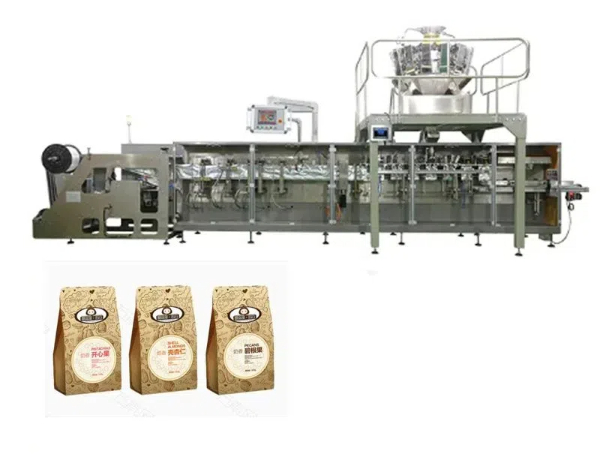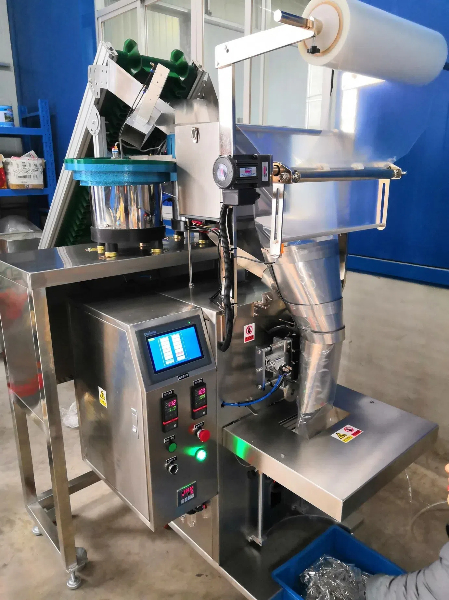
Content Menu
● Introduction
● The Evolution of Dry Food Packaging Technology
>> From Manual to Automated: A Brief History
>> The Rise of Vertical Form Fill Seal (VFFS) Machines
● Key Players in the Dry Food Packing Machine Manufacturing Industry
>> Leading Manufacturers and Their Specialties
● Types of Dry Food Packaging Machines
>> Vertical Form Fill Seal (VFFS) Machines
>> Horizontal Form Fill Seal (HFFS) Machines
>> Multi-head Weighers
● Innovations in Dry Food Packaging Technology
>> 1. Smart Packaging Solutions
>> 2. Sustainable Packaging Options
>> 3. Improved Hygiene and Sanitation
>> 4. Flexible and Modular Designs
>> 5. Enhanced Quality Control
● Choosing the Right Dry Food Packaging Equipment
>> 1. Product Characteristics
>> 2. Production Volume
>> 3. Packaging Material Compatibility
>> 4. Automation Level
>> 5. Maintenance and Support
>> 6. Budget and ROI
● Case Study: Implementing a New Dry Food Packaging Line
● The Future of Dry Food Packaging
● Conclusion
● Frequently Asked Questions
>> Q1: What are the main advantages of using automated dry food packaging machines?
>> Q2: How do I determine the right packaging speed for my dry food production line?
>> Q3: What maintenance is required for dry food packaging equipment?
>> Q4: Can dry food packaging machines handle different types of packaging materials?
>> Q5: How can I ensure that my packaged dry food products have a long shelf life?
Introduction
In today's fast-paced food industry, efficient and reliable packaging solutions are crucial for maintaining product quality, extending shelf life, and meeting consumer demands. Dry food packing machine manufacturers play a pivotal role in this ecosystem, providing innovative technologies that streamline the packaging process for a wide range of products, from grains and nuts to snacks and powders. This comprehensive guide will explore the world of dry food packaging equipment, highlighting the latest trends, key players, and essential considerations for businesses looking to invest in these cutting-edge solutions.
The Evolution of Dry Food Packaging Technology
From Manual to Automated: A Brief History
The journey of dry food packaging has come a long way from manual processes to highly automated systems. In the early days, packaging was a labor-intensive task, prone to inconsistencies and contamination. As technology advanced, dry food packing machine manufacturers began developing increasingly sophisticated equipment to meet the growing demands of the food industry.
The Rise of Vertical Form Fill Seal (VFFS) Machines
One of the most significant innovations in dry food packaging has been the development of Vertical Form Fill Seal (VFFS) machines. These versatile systems have become a staple in the industry, offering high-speed, efficient packaging for a wide range of dry food products.
VFFS machines work by forming a tube of packaging material, filling it with the product, and sealing it in one continuous process. This technology has revolutionized the packaging industry, allowing for faster production speeds, reduced labor costs, and improved package consistency.

Key Players in the Dry Food Packing Machine Manufacturing Industry
The global market for dry food packaging equipment is highly competitive, with several key players dominating the industry. These manufacturers are known for their innovative solutions, reliable machinery, and excellent customer support.
Leading Manufacturers and Their Specialties
1. ABC Packaging (USA): Specializing in custom food packaging systems for various dry food applications.
2. XYZ Machines (Germany): Known for their high-speed VFFS machines and advanced automation features.
3. Global Pack Solutions (Japan): Offers a wide range of flexible packaging machinery for diverse dry food products.
4. EcoPackTech (Netherlands): Focuses on sustainable packaging solutions and eco-friendly materials.
5. InnovaPack (Italy): Renowned for their innovative bulk food packaging equipment and modular designs.
These dry food packing machine manufacturers continue to push the boundaries of technology, incorporating features such as IoT connectivity, AI-powered quality control, and energy-efficient designs.
Types of Dry Food Packaging Machines
Vertical Form Fill Seal (VFFS) Machines
As mentioned earlier, VFFS machines are the workhorses of the dry food packaging industry. They are ideal for packaging a wide range of products, including:
- Snacks (chips, nuts, dried fruits)
- Grains and cereals
- Powders and spices
- Pet food
Horizontal Form Fill Seal (HFFS) Machines
HFFS machines are another popular option for dry food packaging, particularly for products that require a larger package size or a specific shape.These machines are often used for:
- Cookies and crackers
- Granola bars
- Pasta and noodles
- Frozen foods
Multi-head Weighers
These precision instruments work in conjunction with packaging machines to:
- Improve packaging accuracy
- Reduce product giveaway
- Increase overall efficiency
Innovations in Dry Food Packaging Technology
Dry food packing machine manufacturers are constantly innovating to meet the evolving needs of the food industry. Some of the latest advancements include:
1. Smart Packaging Solutions
IoT-enabled packaging machines that offer real-time monitoring, predictive maintenance, and remote diagnostics.
2. Sustainable Packaging Options
Machines designed to work with eco-friendly materials, such as biodegradable films and compostable packaging.
3. Improved Hygiene and Sanitation
Advanced cleaning systems and hygienic designs that minimize contamination risks and simplify maintenance.
4. Flexible and Modular Designs
Packaging systems that can be easily reconfigured to accommodate different product types and package sizes.
5. Enhanced Quality Control
Integration of vision systems and AI-powered inspection tools to ensure consistent package quality and detect defects.

Choosing the Right Dry Food Packaging Equipment
Selecting the appropriate packaging machinery for your dry food products is crucial for optimizing production efficiency and maintaining product quality. Consider the following factors when evaluating dry food packing machine manufacturers and their offerings:
1. Product Characteristics
- Size and shape of the product
- Fragility and handling requirements
- Moisture sensitivity and shelf life considerations
2. Production Volume
- Current and projected production rates
- Seasonal fluctuations in demand
- Scalability requirements
3. Packaging Material Compatibility
- Types of films and materials used
- Sealing requirements (heat seal, ultrasonic, etc.)
- Sustainable packaging options
4. Automation Level
- Desired level of human intervention
- Integration with existing production lines
- Future automation plans
5. Maintenance and Support
- Ease of cleaning and maintenance
- Availability of spare parts
- Technical support and training offered by the manufacturer
6. Budget and ROI
- Initial investment costs
- Operating expenses
- Expected return on investment
Case Study: Implementing a New Dry Food Packaging Line
To illustrate the impact of investing in modern dry food packaging equipment, let's examine a case study of a mid-sized snack food manufacturer.Company: Crunch & Munch Snacks
Challenge: Outdated packaging equipment leading to inefficiencies and inconsistent package quality
Solution: Implementation of a new automated packaging line featuring VFFS machines and multi-head weighers
Results:
- 40% increase in production speed
- 15% reduction in packaging material waste
- 99.9% packaging accuracy
- 30% decrease in labor costs
- Improved product freshness and extended shelf life
This case study demonstrates the significant benefits that can be achieved by partnering with reputable dry food packing machine manufacturers and investing in state-of-the-art equipment.
The Future of Dry Food Packaging
As we look to the future, several trends are shaping the development of dry food packaging machinery:
1. Increased focus on sustainability and eco-friendly packaging solutions
2. Greater integration of AI and machine learning for predictive maintenance and quality control
3. Development of packaging materials with enhanced barrier properties for extended shelf life
4. Adoption of augmented reality (AR) for machine operation and maintenance support
5. Continued emphasis on flexibility and quick changeovers to meet diverse product needs
Dry food packing machine manufacturers are at the forefront of these innovations, working closely with food producers to develop solutions that meet evolving consumer demands and regulatory requirements.
Conclusion
The world of dry food packaging is constantly evolving, driven by technological advancements and changing consumer preferences. By staying informed about the latest innovations and partnering with reputable dry food packing machine manufacturers, food producers can optimize their packaging processes, improve product quality, and stay competitive in a rapidly changing market.
Whether you're a small artisanal snack producer or a large-scale food manufacturer, investing in the right packaging equipment is crucial for success. Take the time to research and evaluate different options, and don't hesitate to reach out to manufacturers for demonstrations and trials. With the right machinery in place, you'll be well-equipped to meet the challenges of the modern food industry and deliver high-quality products to your customers.

Frequently Asked Questions
Q1: What are the main advantages of using automated dry food packaging machines?
A1: Automated dry food packaging machines offer numerous benefits, including increased production speed, improved packaging consistency, reduced labor costs, enhanced hygiene, and the ability to handle a wide range of products and packaging materials. These machines also typically result in less product waste and can extend the shelf life of packaged foods.
Q2: How do I determine the right packaging speed for my dry food production line?
A2: To determine the appropriate packaging speed, consider factors such as your current and projected production volumes, the nature of your product (e.g., fragility, flow characteristics), and your overall production line capabilities. It's essential to choose a machine that can handle your peak production needs while also operating efficiently during normal production runs. Consult with dry food packing machine manufacturers to get expert advice based on your specific requirements.
Q3: What maintenance is required for dry food packaging equipment?
A3: Regular maintenance is crucial for ensuring the longevity and optimal performance of dry food packaging equipment. This typically includes daily cleaning and sanitization, regular lubrication of moving parts, inspection of sealing mechanisms, calibration of weighing systems, and periodic replacement of wear parts. Many modern machines come with built-in maintenance schedules and self-diagnostic capabilities to simplify the maintenance process.
Q4: Can dry food packaging machines handle different types of packaging materials?
A4: Yes, many modern dry food packaging machines are designed to work with a variety of packaging materials, including traditional plastic films, biodegradable options, and even paper-based materials. However, it's important to verify compatibility with your specific packaging materials when selecting a machine. Some machines may require adjustments or specific modules to handle certain materials effectively.
Q5: How can I ensure that my packaged dry food products have a long shelf life?
A5: To maximize the shelf life of packaged dry food products, consider the following factors:
1. Choose appropriate packaging materials with good barrier properties against moisture and oxygen.
2. Ensure proper sealing of packages to maintain a protective environment.
3. Implement nitrogen flushing or other modified atmosphere packaging techniques when applicable.
4. Use packaging machines with precise dosing capabilities to minimize air in the package.
5. Maintain strict hygiene standards throughout the packaging process.
6. Consider incorporating oxygen absorbers or desiccants for moisture-sensitive products.
Consult with dry food packing machine manufacturers to find equipment that can support these shelf life-extending techniques for your specific products.












